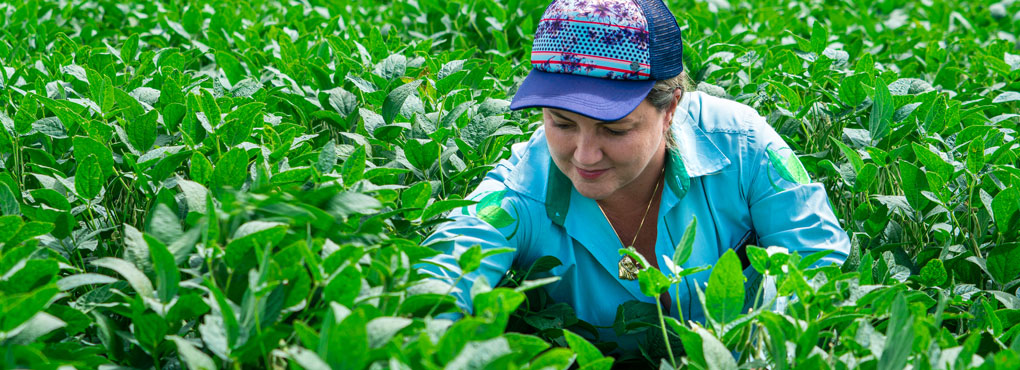Rural producer from Unaí (MG).
GRI 102-40, 102-42 and 102-43
The definition of inpEV’s main activity topics is done based on a materiality process which takes into account the perception of stakeholders with whom the Institute maintains relationships and the day-by-day reality. In the most recent analysis, done in 2017, these issues were grouped into eight topics that summarize the key areas in which the Institute creates an impact and has the potential to expand its positive influence.
PROCESS
1 - IDENTIFICATION
Relevant topics are listed based on document analysis (internal guidelines, sector studies and prior materiality) and a revision, by the management team, is conducted of the main impacts, involved parties, and areas.
2 - PRIORITIZATION
External and internal interviews and online consultation with managers, employees and associates helped prioritize the topics.
3 - STRATEGIC VALIDATION
inpEV’s board of directors performs the strategic validation of the material topics list.
Below is a detailed description of each material topic, its relevance to inpEV, and an indication of where each impact occurs and where to find more information.
INPEV MATERIAL TOPICS
Click on the icons to learn more
OPERATIONAL EXPANSION
Why is it material
To keep in pace with the expansion of agricultural frontiers and production growth of the sector is fundamental for the effectiveness of the Campo Limpo System.
The disposal structure may allow for the future incorporation of waste management from other sectors and contribute towards achieving inpEV’s vision of reaching financial self-sufficiency.
Aspects considered
Geographic expansion; processing of other crop protection packaging materials.
Impact extent
Outside inpEV.
INPEV MATERIAL TOPICS
Click on the icons to learn more
OPERATIONAL EXPANSION
Why is it material
To keep in pace with the expansion of agricultural frontiers and production growth of the sector is fundamental for the effectiveness of the Campo Limpo System.
The disposal structure may allow for the future incorporation of waste management from other sectors and contribute towards achieving inpEV’s vision of reaching financial self-sufficiency.
Aspects considered
Geographic expansion; processing of other crop protection packaging materials.
Impact extent
Outside inpEV.
LOGISTICS
Why is it material
A complex logistics operation allows for the disposal of empty packages across the entire Brazilian territory. inpEV is responsible for transporting packaging from the receiving units until its final destination, which is done thanks to planning, technology, systems and traceability of the entire chain. Shipping costs management is an ongoing point of attention.
Aspects considered
Reverse logistics; safe routes; logistical infrastructure; packaging return facility and transportation conditions.
Impact extent
Outside inpEV.
OPERATIONAL ECO-EFFICIENCY
Why is it material
The search for more sustainable processes and more efficient facilities are also a constant. And impact assessment studies calculate the environmental benefits of the System, which avoids greenhouse gas emissions as well as the use of natural resources.
Aspects considered
Natural resource management; use of materials, water and energy; reduction and recycling of materials arising from operations; sustainable facilities and emissions.
Impact extent
Outside inpEV.
INNOVATION & TECHNOLOGY
Why is it material
The Institute is always seeking more efficient ways of doing more in a better fashion, either by means of process innovation (e.g., unwashed packaging compacting, receipt of post-consumption leftovers or the change in the empty packaging washing procedure), or with regard to products (new technologies for the Ecoplástica® and Ecocap® packaging). This systemic vision has made the Campo Limpo System become a reference in circular economy.
Aspects considered
Innovation and technology in operations.
Impact extent
Inside and outside of inpEV.
HUMAN DEVELOPMENT
Why is it material
The Institute develops competencies to stimulate continuous evolution and innovation, besides technical specialization in packaging reverse logistics and circular economy.
Aspects considered
Career management; employee training and development; internal career planning; talent attraction and retention.
Impact extent
Inside inpEV.
EDUCATION AND AWARENESS
Why is it material
inpEV seeks to go beyond raising farmer awareness and uses the capillarity of the Campo Limpo System to promote environmental education to students and communities regarding topics such as mindful consumption and shared responsibility in various contexts. To promote education and awareness is a determination set forth by legislation for manufacturers, distribution channels and the public power.
Aspects considered
Education and awareness of communities close to the receiving units or regions considered critical for the correct disposal of packaging material; environmental education for students; actions aimed at farmers.
Impact extent
Inside and outside of inpEV.
MULTI-STAKEHOLDER DIALOG AND COOPERATION
Why is it material
Valuing dialog and cooperation is part of inpEV’s essence. One of its values is an integrating spirit, which reflects the Institute’s leadership characteristic, teamwork, integration among chain links and knowledge dissemination.
Aspects considered
Multi-stakeholder engagement processes; dialog and partnerships; interaction with government and influence upon the public power; sector articulation with a positive influence upon the regulatory environment.
Impact extent
Outside inpEV.
ECONOMIC FEASIBILITY
Why is it material
As a non-profit organization, inpEV’s activities are for the most part funded by its members and, to a lesser extent, by revenue generated by the System itself. The Institute is committed to pursue economic self-sufficiency. For this, it focuses on cost reductions, gains in efficiency and productivity, increase in recycling and it assesses revenue generating opportunities arising from residue management from other agricultural sectors as well as consultancy.
Aspects considered
Economic and financial performance; growth; new businesses; shared value generation.
Impact extent
Inside and outside of inpEV.
